| Report to Congress: October 1, 2000 |
Seattle Region
Moises M. Carrasco serves as Director of the Seattle Regional Census Center.
Following are the states located in the Seattle Region and the Local Census Offices in those
states visited by the Census Monitoring Board:
Alaska
California (Northern and Central): Modesto LCO; Sacramento North LCO; San Francisco Northeast LCO; San Francisco West LCO (CMBP only)
Idaho
Oregon: Portland LCO
Washington: Tacoma LCO
Highlights of the Region include:
- Approximately 9,372,848 Housing Units
- 936,314 Square Miles
- 5 States, 185 Counties
- 1,530 Governmental Units
- 94 American Indian Reservations
- 217 Alaska Native Villages
- 34 Members of the U.S. House of Representatives
- 10 U.S. Senators
- 38 Local Census Offices
Additional items of interest include:
- Largest region in total square miles
- Ranks first among regions in number of American Indian reservations
- Special needs for the enumeration of remote Alaska
- Special needs for the enumeration of San Francisco
MODESTO
Local Census Office #2717
Overview
Dates of Visits:
April 13, 2000
May 24, 2000
June 27, 2000
Mailback Response Rate
68%
NRFU Workload
110,546 housing units
LCO Type
Type C Office (includes mailout/mailback and update/leave areas)
Geographic Description
The Modesto LCO was located at 1012 11th Street in Modesto, California. According to the
February 2000 Tract Action Plan, there were 191 tracts in the LCO, of which 58 (30.37 percent)
were HTE. According to the 1990 PDB, there were 298,301 housing units. The LCO included
two counties — San Joaquin and Stanislaus.
Pay Rates

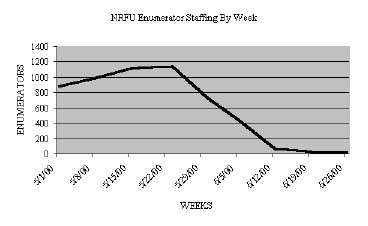
MODESTO
Local Census Office #2717
Presidential Members' Summary
Summary
High mail response, exceptional partnership and recruiting efforts, and diligent managers who
followed regional and national guidelines, combined to make the census a great success in Modesto.
Observations
Mail response actually increased 5 percent from the 1990 census to 70 percent, an
outstanding accomplishment. Further contributing to the success of the Modesto LCO was the exceptional
work of the Assistant Manager for Recruiting and the Partnership Specialist. Both were formally
recognized by Census Bureau headquarters for their exemplary work.
Fifty-eight of the Modesto LCO's 191 census tracts were HTE. The LCOM claimed that the
Modesto LCO area represented about 700,000 people in 1990 but that same area grew to near 1 million
by 2000. HTE tracts in the Modesto area were concentrated in linguistically isolated
communities, waterways and deltas, industrial areas, resorts, areas with poor roads, and areas with high crime
and gangs. The agricultural and food processing industries are the major contributors to the
local economy.
NRFU operations were completed ahead of the national deadline on June 13. This early
success enabled the Modesto LCO to send enumerators to the Sunnyvale LCO to assist in its operations.
Management reported that California Rural Legal Assistance was instrumental in helping
field operations where migrant farm workers reside.
Management of this office heeded a suggestion from former Regional Office Director Bill
Hill, who created a training video directing local census office staff to use automobiles to survey
their LCO's enumeration area. (Hill testified at a March 1999 Board hearing held in Suitland, MD.)
The LCO manager said these "windshield surveys" were helpful for Modesto's employees to get
a better idea of the enumeration area before NRFU began.
Partnership and CCC involvement was exemplary. The two counties (San Joaquin and
Stanislaus) and both major cities in the Modesto LCO area (also includes the City of Stockton)
established CCCs. Each CCC had some local funding, and San Joaquin and Stanislaus Counties
received $88,000 and $66,000 respectively from the California State CCC. LCO Management reported
that this money was spent wisely. For example, some of the San Joaquin County CCC's money went
to a Stockton artist who wrote a census rap song called, "Count Me In."
MODESTO
Local Census Office #2717
Congressional Members' Summary
Summary
The Modesto office received positive publicity for its efforts in encouraging cooperation with
the census. The mail response rates for Modesto and four other towns were above 70 percent,
exceeding the national average and their "90 plus five" goals.
Observations
The Modesto LCO faced difficulty in enumerating due to language barriers, unsafe areas at
night, poor roads, resort areas, gang activity, waterways, industrial areas and migrant workers. The
LCO staff wrote an HTE Action Plan to address the difficult tracts, however it was not provided by
the Seattle RCC, thus it could not be effectively evaluated. During the May 16 Monitoring Board
visit, the LCO staff reported their Plan was in its second iteration because some areas were more
difficult than originally anticipated.
The local CCC established an excellent working relationship with the Bureau. Organizations
like California Rural Legal Assistance, the NAACP and MALDEF were instrumental in
establishing about 100 QACs that served almost 2,400 people and about 100 "Be Counted!" sites that dealt
with almost 1,800 households. The California CCC provided funding to Stanislaus and San
Joaquin Counties for partnership efforts that led to higher-than-expected return rates of census forms
by mail and helped break down barriers that could have hindered the NRFU process. Results from
the Modesto office demonstrated how valuable a local CCC is in ensuring a successful census.
We were concerned with the high number of UAAs reported during the May 16 visit.
Almost 40,000 UAAs were returned to the LCO, due primarily to non-delivery of census questionnaires
to Post Office Boxes (reportedly 90 percent of this total).
During the June 20 Monitoring Board visit, the LCOM described the competitive nature of
NRFU completion. LCOs were pressured by the Seattle RCC to finish their workload earlier than
others, as the RCCs competed to finish first nationally. The Modesto office completed NRFU on June
12, then sent 104 enumerators to work in Sunnyvale (LCO 2729) and 55 others in Concord
(LCO 2713).
At an awards ceremony held in Washington in early May, the Bureau Director, Dr. Kenneth
Prewitt, recognized two staff members of the office for outstanding achievement. The office's
Assistant Manager for Recruiting received the Equal Opportunity Award and the Partnership Specialist
received the Director's Award for Innovation.
SACRAMENTO NORTH
Local Census Office #2721
Overview
Dates of Visits:
April 11, 2000
May 16, 2000
June 20, 2000
Mailback Response Rate
65%
NRFU Workload
86,148 housing units
LCO Type
Type B Office (entirely mailout/ mailback)
Geographic Description
The Sacramento North LCO was located in the Moss Federal Building at 650 Capital Mall,
Sacramento, California. According to the February 2000 Tract Action Plan, there were 95 tracts in
the LCO, of which 18 (18.95 percent) were HTE. According to the 1990 PDB, there were
210,143 housing units. The office was located outside the LCO's boundaries, but near one of its borders.
Pay Rates

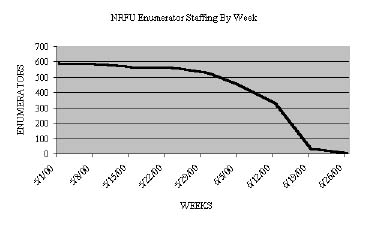
SACRAMENTO NORTH
Local Census Office #2721
Presidential Members' Summary
Summary
Enumeration efforts proved successful at this LCO. The 1998 census dress rehearsal in
Sacramento helped the decennial effort by drawing on previous workers' experience and local awareness.
Observations
Mail response was excellent, totaling nearly 70 percent. It left a smaller than expected NRFU
workload of over 86,000 housing units. With roughly 25 percent of all the tracts determined as HTE
and housing units being primarily suburban, the LCO was well prepared to fulfill its mission.
Recruiting in Sacramento North's jurisdiction proceeded smoothly. The LCO reached 120
percent of its recruiting goal for NRFU by April 11. Recruiters benefited from the Census 2000
dress rehearsal in Sacramento by rehiring enumerators from the 1998 operation. Local retirees,
McClellan Air Force Base residents, and college students ranked among the most popular recruits. While
20 percent of applicants failed the background check, the passing rate for the enumerator and
crew leader tests was high.
In order to resolve some early problems with delivery of materials for pre-NRFU operations such
as Special Places Enumeration, the Regional Office implemented an electronic materials request
system. The paper request system was replaced in late March. Consequently, delivery time
improved from 30-40 days to 7-10 days.
Local and statewide funds for promotion kept awareness of the census high in Sacramento.
The City of Sacramento and the local Complete Count Committee committed $150,000 to
supplement the public awareness campaigns run by the state and the Census Bureau. Additionally, the State
of California allocated $24.7 million to assist localities with their census effort. As the nation's
most undercounted state in 1990, California improved its mail response rate by 5 percentage
points, beating the national average with 70 percent.
SACRAMENTO NORTH
Local Census Office #2721
Congressional Members' Summary
Summary
The Sacramento North office effectively built upon the foundation laid during the 1998 Dress
Rehearsal. Its networking and community presence helped ensured high Initial Rates of Return.
It was a smoothly running office that completed its operations ahead of schedule, especially NRFU.
Observations
The Sacramento North LCO incorporated many lessons from the 1998 Dress Rehearsal:
recruiting culturally sensitive enumerators, working closely with community leaders, and dealing
effectively with HTE neighborhoods.
Believing it placed an additional burden on applicants, the community-based organizations
the LCO worked with persuaded the Bureau to not administer the English Proficiency Test. Of
the 700+ enumerators that were hired, between 150 and 200 were bilingual, fluent in Chinese,
Spanish, Russian, Korean or Vietnamese.
The local CCC established an excellent working relationship with the Bureau and in doing
so, identified the locations and workers that were instrumental in establishing 52 QACs and 139
"Be Counted!" sites. Among such large partners as the NAACP, the Urban League and MALDEF,
the Organization of Chinese-Americans trained over 150 volunteers. The local CCC was also able
to provide volunteers from the Hmong and Lao communities. The California CCC provided
funding to the local CCC, which was used to buy radio and television advertising, list QAC locations
in newspapers and underwrite the cost of the April 1 Cal Expo, an event that attracted over
3,000 attendees. Results from the Sacramento North office demonstrated how valuable a local CCC is
in ensuring a successful census.
To address its 18 difficult tracts, the LCO management team wrote an HTE Action Plan (not
provided to the Monitoring Board), which seemed to be implemented effectively. Within these
18 tracts, there were new immigrants and pockets of language isolation, low-income areas, large
numbers of transient renters and sections where apathy and suspicion of the federal government
were prevalent. The tracts included Asians, Hispanics, African-Americans and growing Russian
and Hmong communities. The HTE areas were completed first. In order to address high-crime
areas, trailer parks and apartment complexes, the Bureau used its blitz enumeration strategy to
complete the NRFU workload.
The area's mail response rate was about 71 percent, which led to a smaller-than-expected
NRFU workload. The office completed NRFU on June 19, thus allowing about one hundred
enumerators to work in three nearby offices.
SAN FRANCISCO NORTHEAST
Local Census Office #2746
Overview
Dates of Visits:
April 7, 2000
May 31, 2000
June 29, 2000
Mailback Response Rate
60%
NRFU Workload
50,022 housing units
LCO Type
Type A Office (entirely mailout/mailback, mainly urban, hardest to enumerate)
Geographic Description
The San Francisco Northeast LCO was located at 600 Harrison Street, San Francisco, California.
According to the February 2000 Tract Action Plan, there were 49 tracts in the LCO, of which
28 (57.14 percent) were HTE. According to the 1990 PDB, there were 113,818 housing units.
The area's composition was approximately 59 percent white, 20 percent Asian Americans (mostly
of Chinese, Vietnamese and Filipino decent) 11 percent African-American, six percent Hispanic
and one percent Native American. The office was located outside the LCO's boundaries, sharing
space with the National Park Service. GSA was unable to secure a lease in the LCO area.
Pay Rates

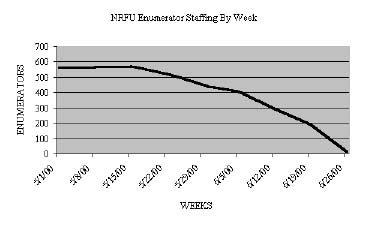
SAN FRANCISCO NORTHEAST
Local Census Office #2746
Presidential Members' Summary
Summary
Given the barriers to enumeration that confronted it _ high mobility, unusual housing units
and diverse cultures and languages — the San Francisco Northeast LCO produced complete and
thorough work. The manager, with over three decades of census experience, boosted the LCO's
performance.
Observations
Although 1990 census numbers dictated that 28 of the LCO's 51 tracts were HTE,
management reported that the area is currently more dense and harder to enumerate than it was ten years ago.
Nevertheless, promotional efforts and awareness were high and mail response was excellent at
60 percent (this result cannot be directly compared to the 1990 census because the LCO boundaries
in San Francisco have changed. Nevertheless, everyone familiar with the census in the area
agrees that the 2000 mail response rate was excellent in the San Francisco North jurisdiction.)
Managers felt their recruiting was successful because they hired many enumerators who were
fluent in English and one of 14 other languages. Most of the hires were part time.
This LCO hired homeless men and women to help conduct the homeless enumeration. The
LCOM emphasized the positive contribution homeless enumerators made. Visa checks (which do
not require a bank account to be cashed) were special issued for payment. Those without bank
accounts or mailing addresses could pick up their checks at the LCO.
The AMFO reported that staff often attempted enumeration more than six times per household.
Keeping within the required time frame, enumerators were encouraged to visit houses four or
more times, if they believed the house could still be enumerated.
The office reported 2,500 contacts with people in need of assistance at the 17 QACs and 43
Be Counted Sites. These QACs were more successful than those in other LCO districts, however,
the LCOM said this operation was time intensive. He recommended eliminating the QAC
operation during the next census unless the QACs can be better advertised.
QACs were originally designed to aid people filling out their census forms. Instead, many
centers served as small Bureau outposts to the community, more useful for answering general
questions about the census than helping people fill out their forms. For this reason, the LCOM
thought selected centers should be open throughout field operations.
Managers said the original address list was very accurate. The City of San Francisco worked with
the Bureau during LUCA and put together an excellent address list. The few issues the office
had to deal with included: the prevalence of residential hotels, corporate offices serving as
temporary living quarters, and a large number of hidden units. For example, some people lived in garages
or in-law suites. The AMFO reported that one man lived in the back room of his store.
Furthermore, the office had some initial difficulty figuring out how to differentiate between consulates and
embassies on the census forms.
Fear of the government and the desire to protect privacy caused a number of violent refusals
during NRFU. The LCOM reported some non-respondents chased enumerators down the stairs and
across the street.
Due to extremely high real estate costs in the LCO district and the unavailability of space in
less expensive areas, the LCO had to locate just south of its jurisdiction. However, this did not
hinder the LCO's work.
SAN FRANCISCO NORTHEAST
Local Census Office #2746
Congressional Members' Summary
Summary
The San Francisco Northeast LCO had one of the most difficult areas to enumerate. Its area
of responsibility includes some of the most affluent, as well as the poorest. Even with a change
in management at the LCO, it was efficiently run and appeared to be on track for a successful census.
Observations
Within the office's HTE tracts, the Bureau was faced with undocumented people, as well as
language and cultural barriers. Many houses in this area have converted apartments, which may not
be in accordance with building codes, but must be enumerated nonetheless. The office's notable
HTE neighborhoods had their own challenges _ Chinatown, linguistic isolation; the Tenderloin,
low income and a high percentage of new immigrants; and the Western Addition, suspicion of
the government. During the 1990 Census, about 2.9 percent of the population was undercounted,
and of those enumerated, half spoke languages other than English in their homes.
Following the office's HTE Action Plan, the Bureau employed a team enumeration strategy
to complete NRFU in Chinatown. A high-level city/county staff member who served as a liaison
to the LCO, said there was a shortage of census questionnaires in Chinese and Chinese
language guides at the outset of the census operations. While the Bureau was able to provide more
Chinese forms and language guides, this official was concerned that the initial shortage hurt efforts to
enumerate the Chinese American population.
During the Special Places enumeration of the homeless, enumerators wore bright orange vests
and carried flashlights that were provided by the City and County of San Francisco in an effort
to improve the enumeration.
Commendably, the office's recruiting efforts were successful in an area with an unemployment
rate below two percent. The office used specific individuals to meet its goals in the minority
communities. Retention was high; dropout and no-show rates were low. The three LCOs in San
Francisco allocated their training facilities and used one toll-free number to coordinate all the testing.
During the June 29 Monitoring Board visit, the LCOM described an ambitious, though
artificially imposed, deadline of June 20 for the completion of NRFU. LCOs were pressured by the
Seattle RCC to finish their workload earlier than others. The San Francisco Northeast office
completed NRFU on June 18, though LCO staff was uncertain why the Seattle RCC had accelerated the
deadline.
Although the office completed Reinterview on June 28, the LCO staff was concerned with
its integration into the bulk of the NRFU phase. Reinterview, the Bureau's quality control
procedure, is designed to compare data collected by enumerators with data collected by telephone agents.
Resulting from this process, 14 enumerators were dismissed for failing to fill out forms
correctly and one was terminated for outright falsification. Based on the amount of visits we
conducted, these figures seem to be consistent with other offices.
Under the leadership of Mayor Willie Brown and the County Board of Supervisors, the San
Fransisco CCC was established. Of note, the City and County of San Francisco allocated $350 thousand
in the Fiscal Year 2000 budget for the committee. The California CCC and the San Francisco
Foundation also provided funding for partnership efforts. Organizations like the NAACP, the
Urban League, MALDEF, Chinese Newcomers, and Chinese for Affirmative Action were instrumental
in establishing about 20 QACs that served almost 2,500 people. Results from the San Francisco
Northeast office demonstrated how valuable a local CCC is in ensuring a successful census.
SAN FRANCISCO WEST
Local Census Office #2725
Overview
Date of Visit:
April 7, 2000
Mailback Response Rate
69%
NRFU Workload
37,291 housing units
LCO Type
Type A Office (entirely mailout/mailback, mainly urban, hardest to enumerate)
Geographic Description
The San Francisco West LCO was located at 301 Howard Street, San Francisco, California.
According to the February 2000 Tract Action Plan, there were 49 tracts in the LCO, of which 31
were HTE. According to the LCOM, the LCO encompassed approximately 122,000 housing units.
This LCO was responsible for the enumeration of a large number of multi-family units,
undocumented residents and minority communities such as Asian-Americans, Latinos, Russians, and Eastern
Europeans.
Pay Rates

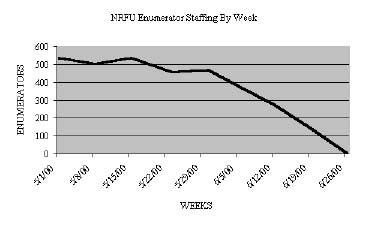
SAN FRANCISCO WEST
Local Census Office #2725
Presidential Members' Summary
Summary
The San Francisco West LCO jurisdiction achieved a high mail back rate (69 percent),
effectively narrowing the scope of NRFU coverage to approximately 37,000 housing units. Due to the
development of a detailed Hard-to-Enumerate plan and staff commitment, census takers overcame
significant enumeration challenges presented by the LCO's dense, racially and ethnically diverse
urban setting.
Observations
The LCOM, a Vietnamese-American with strong ties to local community groups and elected
officials, attributed the LCO's success principally to the Bureau's support and faithful
implementation of its operating procedures. The LCOM specifically praised the Bureau for developing a
strong management training program and responding quickly to requests for materials and supplies.
QACs and Be Counted sites were established in areas that drew significant traffic. The
materials and information that were distributed personalized the census for those who otherwise might
not have participated.
By all accounts, the LCO succeeded in recruiting qualified staff despite obvious difficulties in
such a strong economy. Competitive pay rates set by the Bureau proved invaluable in attracting
and retaining personnel throughout the census operation.
While communication between field staff and management went reasonably well, the level of
interaction would have been better if the LCO was located within its enumeration jurisdiction. We
drew the same conclusion in other LCOs we visited, including San Francisco West, Boston South,
Los Angeles West Central and San Diego South. In these locations, the General Services
Administration could not find adequate LCO space on a temporary lease.
Local and state elected officials are to be commended for enhancing the LCO's public
outreach effort. San Francisco's Complete Count Committee was said to have helped educate residents
of the importance of filling out their forms and urging them to cooperate with enumerators. In
addition, the State of California allocated $24.7 million to assist localities with their census effort.
As the nation's most undercounted state in 1990, California improved its mail response rate by 5
percentage points, beating the national average with 70 percent.
SAN FRANCISCO WEST
Local Census Office #2725
Congressional Members' Summary
[The Congressional Members of the Monitoring Board did not visit the San Francisco
West LCO.]
PORTLAND
Local Census Office #2735
Overview
Dates of Visits:
March 27, 2000
May 8, 2000
June 14, 2000
Mailback Response Rate
69%
NRFU Workload
92,732 housing units
LCO Type
Type C Office (includes mailout/mailback and update leave enumeration areas)
Geographic Description
The Portland LCO was located in the Customs House Federal Building at 220 NW Eighth
Avenue, Portland, Oregon. According to the February 2000 Tract Action Plan, there were 160 tracts in
the LCO, of which 44 (27.50 percent) were HTE. According to the 1990 PDB, there were
255,751 housing units. The office's jurisdiction had a rapidly growing Hispanic population and
substantial Slavic and Asian communities.
Pay Rates

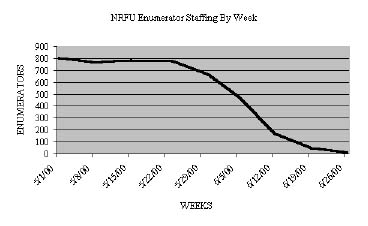
PORTLAND
Local Census Office #2735
Presidential Members' Summary
Summary
This LCO was responsible for operations in the city of Portland and its suburban environs.
Despite a recent influx of non-English speaking immigrants, the office achieved a 69 percent
mail-response rate, 3 percent better than in 1990.
Observations
The Portland office's management team was exceptionally seasoned and competent. The
LCOM had prior Bureau experience, having occupied the same position in 1990. Since it possessed
institutional memory and experience, the office found it relatively easy to tap into the network of
local community leaders and political officials.
Thanks to its high mail-response rate, Portland's NRFU workload was smaller than originally
anticipated. The LCOM noted that this census was the best publicized in history and that
heightened public awareness contributed to the success of NRFU operations. Managers in San Francisco,
San Antonio and Philadelphia echoed this praise.
The office commenced NRFU operations the last week in April and finished on June
13th—putting it close to first in the Seattle Region. Management in Portland, like in many other offices visited
by Board staff, reported that the widely publicized comments of certain national political figures
and media personalities regarding the public's duty to complete the long-form added to the
LCO's burden. Portland's experience was confirmed by a May 2000 report by InterSurvey that found
"the public controversy over the long form had a negative impact on census participation."
The office found that the Planning Database—which was integrated with thematic mapping
technology to great effect—contributed to its success; for, save one exception, the 2000 HTE
tracts were identical to those in 1990.
Portland surpassed its recruiting goal by a factor greater than two and the office never faced
any turnover problems or staffing shortages. Indeed, it was able to assist the Salem, Eugene, and
Eureka offices—supplying upwards of 30 enumerators to each. The LCOM attributed
Portland's success to competitive wages, a training regime and supervisory structure conducive to good
morale, and the practice of tracking recruiting on the tract level. Additionally, Portland addressed
the challenges posed by part-time employees working few hours up-front. A concerted effort to
hire full-time employees was undertaken. Applicants were made to understand that the office
expected part-time workers to put in 25 hours per week and part-time and full-time employees were
grouped into separate crews.
Portland worked closely with county government officials and succeeded in establishing solid
relationships with the Mayor and the CCCs. Area CCCs were very active and contributed to the
LCO's successful outreach to minorities. The fruit of these efforts was made evident by the over
2,200 visits to the 75 Questionnaire Assistance Centers (QACs.)
PORTLAND
Local Census Office #2735
Congressional Members' Summary
Summary
The Portland LCO faced the challenge of trying to count a large Russian immigrant
population without Russian language materials. The LCO incorporated suggestions from community
groups in the HTE strategy, and used its CCC to assist recruiting.
Observations
Within the office's 44 HTE tracts, there were ethnic, language and cultural barriers, as well as
a mistrust of government. During the 1990 Census, an estimated 1.7 percent of the population
in these tracts were undercounted.
The LCO made an attempt to solicit advice from community groups, which resulted in
suggestions that appeared to be helpful. For instance, community groups encouraged the Bureau to
employ local facilitators and bilingual enumerators, rather than blitz enumeration, in its HTE
neighborhoods.
The LCO established a good working relationship with the local CCC that assisted the Bureau
in recruiting over 6,000 potential employees. Volunteers from religious organizations rounded
out the efforts, especially in the office's six worst HTE tracts, where crime rates were high.
Although approximately 3,900 forms, many intended for apartment complexes, were returned
to the LCO as UAA, the LCO reported that they were able to deal with these effectively. In
addition, to the office's credit, enumerators reportedly made more than the required six visits to
households during NRFU.
The Portland Russian community could have benefited from Russian language materials. We
learned from a local pastor that "half" of his Russian-speaking community had thrown away their
forms and Notices of Visit because they could not read English. The census questionnaire was available
in only five languages other than English (Spanish, Chinese, Tagalog, Vietnamese and Korean).
Certainly, these six languages are the most common as there are spoken by 99 percent of the people
in America, however, significant populations of Russian speakers (among others) do exist, as is
the case in Portland. To gain trust, the LCO enlisted the help of church and associated religious
leaders in order to get the information out to the Russian community.
TACOMA
Local Census Office #2745
Overview
Dates of Visits:
March 27, 2000
May 8, 2000
June 14, 2000
Mailback Response Rate
61%
NRFU Workload
114,835 housing units
LCO Type
Type C Office (includes mailout/mailback and update/leave enumeration areas)
Geographic Description
The Tacoma LCO was located in the Tacoma Security Building at 917 Pacific Avenue,
Tacoma, Washington. According to the February 2000 Tract Action Plan, there were 117 tracts in the
LCO, of which 80 (68.38 percent) were HTE. According to the 1990 PDB, there were 228,842
housing units. The office had a large ethnic mix (including Cambodians, Russians,
African-Americans, Vietnamese, Koreans and Hispanics) and two military installations in the surrounding area.
Pay Rates

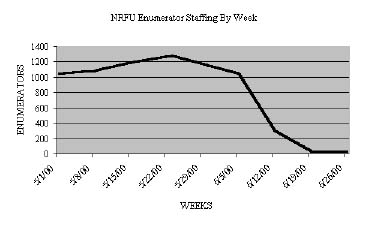
TACOMA
Local Census Office #2745
Presidential Members' Summary
Summary
Given the recent influx of Asian and Slavic immigrants, which management judged impacted
Census awareness in the aggregate, efforts in this office met with a surprising degree of success.
The Tacoma LCO met its recruiting goal and completed NRFU operations on time despite its lower
than expected mail response rate of 61 percent.
Observations
Though it met its initial recruiting goal, the LCO faced staffing shortfalls. Approximately 25
percent of the qualified applicants who were offered jobs did not appear for training. Of those that
did show up, more than 40 percent dropped out by the second day. And among those who
completed the training, some 20 percent did not stay for the long-term. Consequently, the LCO had only
half the staff it needed when NRFU operations commenced, and it was forced to implement a large
scale new and replacement staff training regime. The LCOM conjectured that low unemployment was
a contributing factor.
The office received a myriad of long-form complaints. In keeping with the nationwide trend,
enumerators reported that more than a few respondents said that they mailed back their forms and
did not understand why someone was knocking on their door. The LCOM thought many of
these complaints could be attributed to respondents mailing their forms back too late to avoid
being included in NRFU. The April 1st reference date and the lack of an IRS-style mail-back
deadline may have confused the public.
Notwithstanding its staffing challenges, Tacoma managed to complete NRFU operations in
mid-June, meeting the RCC's target completion date. Early on, the LCO saw a shift in HTE
tracts toward the south. For example, according to the Planning Database, in 1990 the Hilltop area
had the highest HTE concentrations. This time around, however, it was Lakewood. University Place
(a newly incorporated entity) proved easiest to enumerate, thanks in large part to involvement of
its government officials.
The relationships the LCO cultivated with the Tax Assessor's office and the fire department
in Pierce County yielded positive results. The County Tax Assessor's office was able to train
census personnel on the use of its database. This information was especially helpful to locate
knowledgeable sources on renter occupied units. The fire department provided enumerators with codes
for gated communities where enumerators faced problems gaining access.
Staff accompanied enumerators working NRFU cases in the Hilltop neighborhood of Tacoma
in early May. The friendly persistence of the enumerators often elicited respondent participation, en
abling the short forms to be completed in less than five minutes. As in the other offices
visited, "Notice of Visit" flyers served as useful calling cards for people who were not at home.
However, the flyers were printed only in English. The Board believes that in 2010 such notices should
include information in other dominate languages, much as the "Advance Letter" did.
TACOMA
Local Census Office #2745
Congressional Members' Summary
Summary
The Tacoma LCO was responsible for enumerating a very diverse community in an urban/rural
mix that also included several military installations and Indian reservations. The office appeared
to meet its challenges, though recruiting was difficult and many enumerators faced threats to
their well being.
Observations
Within the office's HTE tracts, the Bureau had to overcome a mistrust of government, resistance
to the long form and the methods in which the data was collected. High crime and a
significant homeless population in shelters also characterized the HTE tracts. The Bureau employed
local facilitators, identified by the local CCC in partnership with tribal governments, to improve
the enumeration on two Indian reservations. The HTE Action Plan included the blitz
enumeration strategy, even though its implementation did not always go as planned. For example, at one set
of high-rise apartments, 20 enumerators were assigned to canvas the building, but because the
office manager had to accompany them, the net effect was a single enumerator, rather than 20. The
blitz enumeration strategy was used effectively in 15 local trailer parks.
We are concerned with the results of recruiting efforts. Specifically, we noted a high rate of
turnover (reported at 70 percent during the June 13 Monitoring Board visit) and a high amount
of dropouts after the first day of training (reported at 44 percent during the May 9 visit). During
the March 27 Monitoring Board visit, the LCOM reported about 800 potential employees could
not pass the background check. Although the office exceeded its hiring goal for enumerators
during NRFU, about 25 percent of identified applicants failed to show up for enumerator training and
10 percent did not appear for work upon the completion of training (reported during March 27 visit).
Reportedly, some did not understand an enumerator's job requirements. Of the office's 54
CLs, five were released, due to cultural and language barriers which prevented their effective
employment. Recruiting in the Vietnamese and Cambodian communities was reported as difficult.
Due to the Bureau's Post Office Box non-delivery policy, residents of the three towns of
South Prairie, Roy, and Gig Harbor were missed, which affected about ten thousand households.
Households that received their mail at Post Office Boxes were treated like NRFU cases. Due to
ongoing conversions to E-911 style addressing, other residents received duplicate forms because of
multiple addresses and their various iterations.
The city of University Place, incorporated in 1995, posted an impressive mailback response rate
of 73.1 percent, the highest response rate within the LCO's territory.
Bureau staff used innovative methods to reduce the amount of proxy data that was gathered by the
Tacoma LCO. Working in conjunction with the Pierce County Assessor's office, and after
receiving three hours of training on research techniques, FOSs obtained the owners' names and
renter information. This was a successful use of administrative records to improve local accuracy,
which we highlighted in our February 1, 1999 report to Congress.
The Tacoma office faced a surprising amount of danger to its enumerators. During the June
13 visit, the LCO staff disclosed that there had been four shootings at enumerators in rural areas
and two enumerators had had guns pulled on them within the city limits. One 18-year old
enumerator was assaulted by four teenagers and lay on the sidewalk for over an hour before regaining
consciousness. As result of his injuries, he missed his school's graduation. A 71-year-old
enumerator had a minor heart attack after a gun was pointed at her. Two workers in Pierce County
were assigned to enumerate a building that turned out to contain methamphetamine labs. Both
workers inhaled the fumes and were hospitalized.





